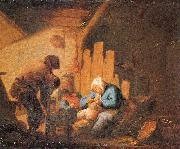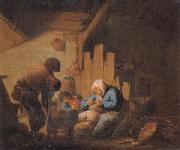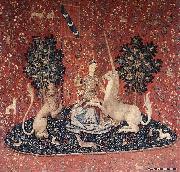
|
Maffei, Francesco
|
|||
|
|
|||
| Italian Baroque Era Painter, 1605-1660 Italian painter. He probably trained with his father, Giacomo Maffei, before joining the workshop of the Maganza family in Vicenza. His early works, such as the Ecce homo (ex-Dianin priv. col., Padua, see Pallucchini, 1981,), were influenced by the eclectic style, between Veronese and the Bassani, of Alessandro Maganza. The St Nicholas and the Angel (1626; Vicenza, S Nicola da Tolentino), with colours like those of Veronese, yet lighter, suggests Maffei's rapid development of an independent style that is both rugged and moving. His interest in narrative, already evident in scenes from the Life of St Cajetan (Vicenza, S Stefano), was developed in the later Martyrdom of the Franciscan Minors at Nagasaki (Schio, S Francesco), which is datable to about 1630. Here, the contrast between the pale, silvery tones of the background and the darker foreground figures is derived from Tintoretto, but the exaggerated Mannerist treatment of the main figures also recalls the art of such French engravers as Jacques Bellange and Pierre Brebiette. At the same time there is also an echo of the extreme stylizations of Giovanni Demio. | |||
|
|
|||
|
Sight new5/Maffei, Francesco_PRDEtk.jpg Painting ID:: 19242 |
1657-58 Oil on canvas. | ||
|
|
|||
|
Ostade, Adriaen van
|
|||
|
|
|||
| Dutch Baroque Era Painter, 1610-1685 Painter, draughtsman and etcher. According to Houbraken's rather unreliable biography, he was a pupil concurrently with Adriaen Brouwer of Frans Hals in Haarlem. Hals influenced him very little, whereas Brouwer, who was described as 'known far and wide' as early as 1627, had a decisive influence on the evolution of Adriaen van Ostade's always idiosyncratic portrayal of peasant life. The first documentary mention of Adriaen van Ostade as a painter is in 1632 (Schnackenburg, 1970). Most of his paintings are signed and dated, the earliest firmly dated example being the Peasants Playing Cards (1633; St Petersburg, Hermitage). | |||
|
|
|||
|
Sight new5/Ostade, Adriaen van-996788.jpg Painting ID:: 19720 |
Oil on panel The Hermitage, St. Petersburg. | ||
|
|
|||
|
Adriaen van ostade
|
|||
|
|
|||
| Dutch Baroque Era Painter, 1610-1685 Painter, draughtsman and etcher. According to Houbraken's rather unreliable biography, he was a pupil concurrently with Adriaen Brouwer of Frans Hals in Haarlem. Hals influenced him very little, whereas Brouwer, who was described as 'known far and wide' as early as 1627, had a decisive influence on the evolution of Adriaen van Ostade's always idiosyncratic portrayal of peasant life. The first documentary mention of Adriaen van Ostade as a painter is in 1632 (Schnackenburg, 1970). Most of his paintings are signed and dated, the earliest firmly dated example being the Peasants Playing Cards | |||
|
|
|||
|
Sight new3/Adriaen van ostade-472727.jpg Painting ID:: 28332 |
mk60 Oil on panel 8x10" | ||
|
|
|||
|
unknow artist
|
|||
|
|
|||
|
|
|||
|
Sight new21/unknow artist-438377.jpg Painting ID:: 63963 |
1500 Wool and silk, 300 x 303 cm Musee de Cluny, Paris The picture shows a tapestry representing Sight from the Five Senses Tapestries that were made for a member of the le Viste family of Lyons - probably Antoine le Viste - at the end of the fifteenth century. Though few have survived into the present, tapestries like these were the most sought-after, expensive and important of the Gothic luxury arts in the later Middle Ages in northern Europe. They were carried from castle to castle, providing warm hangings against draughts and a sumptuous setting for court spectacles. Their densely patterned floral grounds provided the backdrop for stories from the Bible, classical epics, and chivalric romances. Most came in sequences that could create a theme for a room, transforming bare walls into an exotic setting or, as with le Viste's series (sometimes called "La Dame a la Licorne"), a space for erotic experience. This series of tapestries was made as an engagement present in which the patron could present his future betrothed with an art of love based on his future expectations of sensuous pleasure. The lover, Viste himself, is not present as a person in the tapestries, but in each of them he is represented by his heraldic emblems, the lion and the unicorn. Only a beautiful lady, according to the traditional bestiary story, could tame the enigmatic unicorn. Thus, in the Sight tapestry, the lady herself does not look in the mirror, but makes the unicorn, playing like a pet in her lap, admire his own reflection. The way in which the lady's clothing illusionistically recreates within the medium of tapestry itself other expensive types of woven and embroidered threads and the sophisticated way in which natural forms, leaves, and sexual symbols like rabbits are sprinkled into an otherwise flat field, exhibit the most refined expression of Gothic art. , Artist: UNKNOWN MASTER, French , Sight , 1451-1500 , French , painting , mythological | ||
|
|
|||
|
Also Buy::. For Following Paintings / Artists / Products, Please Use Our Search Online: |











